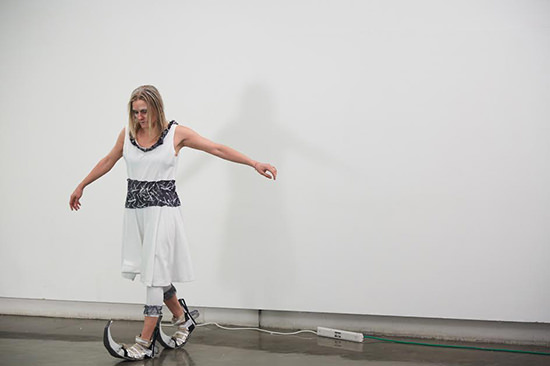Salamanca Moves: making visible dance’s diversity
Keith Gallasch: interview, Kelly Drummond Cawthon

Liz Aggiss, The English Channel
Any festival that boasts the UK’s Liz Aggiss as a headliner is a must, especially when she’s in the company of Portugal’s Ana Beatriz Degues, Townsville’s Dancenorth, Melbourne’s Stephanie Lake and James Batchelor, Brisbane’s Liesel Zink and Tasmanian groups Tasdance, Second Echo Ensemble, MADE, Stompin and Drill. Salamanca Moves’ monumental program is to be staged in the last two weeks of September. The festival is a welcome, highly distinctive and richly inclusive addition to Australia’s contemporary dance festivals and events—Melbourne’s Dance Massive, Perth’s MoveMe and the Keir Choreographic Award.
Appearing in the festival’s Mature Moves program, Aggiss, a UK dancer in her 60s, will present two works, The English Channel—in which, with spoken word, dance and film, “she becomes an unwitting channel for wilful women and forgotten archives”—and Slap and Tickle, an hilarious performance “that embodies feminist dance practices [and] is framed by the politics that challenge and resist the ‘authority’ of formal conventions, revising attitudes towards mature female visibility” (program). Aggiss will appeal not only to dance audiences but lovers of contemporary performance and live art. You’ll find excerpts from her works online.
The Salamanca Moves program suggests that the festival is very much about diversity but, above all, making diversity visible—as I discovered when I spoke by phone with the festival’s curator Kelly Drummond Cawthon.
Tasmanian dance fanciers, artists, the public and interstate visitors are to be treated not only to a variety of performances but also intensive workshops, forums, guidance for young artists, the revival and reworking of could-be classics and a number of public events. The festival’s range of talent is considerable, from secondary school performers to artists in their later years, with practical programs encompassing how to make dance magic with new media and address health and ageing through dance.
Drummond Cawthon, who is Salamanca Arts Centre’s Live Art + Education Coordinator, was raised in Tasmania and after starting out in acrobatics and musical theatre moved into dance. She travelled to the United States to pursue an MFA degree in dance choreography and performance at Florida State University and an MA in Performance Studies at NYU. Working in the US for 20 years, she danced with numerous companies, made widely travelled works, taught in the University of Florida School of Theater and Dance faculty and developed curricula in, among other fields, transdisciplinary collaborations and new media and was involved in the founding of the Digital Worlds Institute, participating in its online collaborative performances. The festival’s range of performances, workshops and discussions reflect the range of Drummond Cawthon’s interests and passions. I asked about the key artists and features of the festival.
—

Ana Beatriz Degues
Salamanca Moves includes a Creative Intensives program of two to five-day workshops with Australian and international artists such as Sannamaria Kuula from Finland and Neta Pulvermacher from Israel. Another is Ana Beatriz Degues who sings as well as dances with highly focused slowness and has created some intriguing site works. Tell me about her.
She’s from Portugal. A couple of years ago she did some dancing with us here at Salamanca Arts Centre. She’ll perform her site-specific dance, El árbol in the Salamanca courtyard and also run a workshop she’s been wanting to do for quite a while, titled From Horizontal to Vertical, looking at the health benefits of dancing—at the spine and how you can keep it flexible and working.
You have a Youth Dance Program. How does that work, through workshops or performances?
In the last week of school term, which is the beginning of the festival, we’ll be taking the festival into schools and the Moonah Arts Centre. High schools will participate on one day and colleges—those where students are studying dance as an academic subject—on the other. We’re looking at dance pathways into the academy or into higher learning. Each school will present a work created by the students. We’ll have Movers-in-Residence who’ll get together with students and talk to them about their work and also about opportunities.
We have fantastic youth companies here on the island that exist outside the competitive dance world: Stompin in Launceston and Drill in Hobart. So, for the other part of this program, I’ve brought them together for the first time, to share an evening program at the Moonah Arts Centre.
At the other end of the age spectrum is Mature Moves, described in the program as “an event celebrating mature dance, and challenging the conventions of aging through dance.”
We’re calling it an “un-convention.” It’s a two and a half-day celebration presented by Tasmania Performs of older movers and move-makers. We have keynote addresses from Jill Sonke, Director of Dance Arts and Medicine at the University of Florida, and the extraordinary Liz Aggiss, who is in her 60s, as a featured performer. There’ll be performances by Tasmania’s astounding Mature Artist Dance Experience (MADE), panels, presentations—including the ground-breaking Glen Murray of [in]visible practice—and workshops. Then, on the last day, we’ll have Mature Moves in Concert with any or all of the participants having an opportunity to get up on the stage. Dancers grow old but they can still dance. We just change which body parts are moving, depending on which bits are hurting on the day.

Aeon
BYO-V(enue) is a gnomic title for a program.
We’re looking at completely breaking dance out of the concert stream. Sometimes you can’t get to an audience because they can’t get to you. So, I’ve tagged and encouraged movers to create a work and to figure out how to activate it outside a theatre; asking, how do you make it come alive in a new way?
Lz Dunn is one of the artists leading this project with a work called Aeon, A Listening Movement, which is about listening, birds flocking and group navigation. Alice Taylor, a local artist and the producer of Aeon, is working with members of local dance schools, dance studios and community groups. Participants, each carrying a little sound speaker [sound by Brisbane’s Lawrence English], move about with the dancers in the performance.
Dance in public space figures strongly in your program.
We have Liesel Zink coming from Brisbane with her work, The Stance, about the body in public protest which will be performed in Salamanca Square. It’s an awesome work. The participants have already done a workshop, Calling All Dance Agents For Change! with Liesel and Bec Jones from Tasdance to inspire them. They’ll be popping up on both Saturdays of the festival all around the Salamanca Market.
In the Making is about works already in-progress?
It’s about thoughts in progress, not yet complete. I’m encouraging the artists who’ve put themselves forward to be brave and show us things, even if they’re not really working. Something’s there, but maybe it’s failing and you need feedback. So often when we do a showing we only show the good bits—kind of like the trailer of a movie. We don’t really need to see that. This is an opportunity for artists to show the kernel of an idea which will be mediated by different Movers-in-Residence. We’ve got two programs. There’s been a lot of interest.

Second Echo, Rite of Spring
Of dance works you’ve mentioned Aeon and The Stance. I see, among others, there’s also a Rite of Spring.
Of course! If you’re doing a dance festival, you must have a Rite of Spring. This is a re-imagining, of course, performed by Second Echo Ensemble and co-presented by the Tasmanian Theatre Company. It’s a processional work in four acts. It’s about two hours long and it travels around four venues in the Salamanca Precinct. I’m really excited about it. Second Echo was founded by playwright Finegan Kruckemeyer and is an integrated ensemble involving people with and without disabilities. Most of them have been working together for 10 years.
I’m the Creative Producer on this ensemble-devised work. We worked all of last year and presented a preview of each act independently. We were at Raw Space for Ten Days on the Island and we went to Brisbane to perform another act. Now we’re bringing all four together. It’s mammoth!
Tell me about the MOV-ies program and your American guest curator.
Cari Ann Shim Sham teaches Dance and New Media at New York University Tisch School of the Arts and has curated an international program of shorts and several features. The rule was each film had to be made by a mover, someone who identifies as such. It could be about anything.
Cari Ann will be here as one of our Movers-in-Residence at the Festival Hub each day with technology and cameras. In her Creative Intensive you learn how to dance with or for your iPhone, to make avatars dance, how to work with software, and screens, to work solo or in a group. Three hundred and sixty degree dancing I think she calls it. We’ll upload the short films onto our website on the last day of the festival.
In Re-works you’re reviving works by Wendy Morrow, Glen Murray, Julie-Anne Long, Neil Cameron, Ina Sladic, Rob Flehr and the Wagana Aboriginal Dancers. These have been performed for one season and then never seen again.
It’s difficult, in contemporary practice especially, to generate new classics. We’ll see works, for example, that were performed in Launceston but never made it to Hobart, and pieces that were performed in the 1980s and 1990s making a come-back. And we’re looking not just at re-presentation, but re-working, seeing what a work turns into now.
I see you’ve programmed a large-scale interactive public performance called Relax the Chimp—a strange title. It’s subtitled “An Experimental DJ Dance Party.”
This is from Felicity Bott, the new Artistic Director of Tasdance. From what I understand, ‘relaxing the chimp’ is about when you’re trying to relax your mind to find what triggers the dance in you. There’ll be workshops where you can learn parts of a dance, create an avatar, use choreographic software to animate it and have it projected by VJ Nick onto a large screen in the Salamanca Courtyard. The public can submit favourite songs which DJ Chimp is turning into a soundtrack.
We’re throwing the ‘relax the chimp’ idea in at high speed on that last day of the festival when all the Creative Intensives participants and local cultural groups will perform. We’re calling it Salamanca Moves at 30,000 Feet, from an idea of VJ-DJ Darren Hunnerup about travelling around the world and visiting different musical ideas. I’ve bent the idea a little to travelling to places both real and imagined at different times—past present and future—and dropping into everything which has moved us or that we want to move. Instead of a big gala we’re ending the festival with little bits and pieces made by the festival’s participants, saying, yes, go out and finish them!
I see that Stephanie Lake, who is presenting her Dancenorth commission If Never Was Now was a Stompin performer when she was young and is Salamanca Moves’ patron.
Yes, she’s a Tassie girl. We shouldn’t celebrate only completely established, long-living artists. Here we have a young artist really making a name for herself and we thought, this reflects our festival. She’s fantastic. She’s been back and forth. Her work is being performed on the 16th, before the festival, but we’re opening up the theatre to everyone here working on or participating in the festival—a bit of a kick-off party.
The vision for the festival is of dance for everybody. It’s a very embracing approach.
I’m really passionate about the diversity of the dancing body and that everybody can dance. We all move and this festival is really looking at what triggers that movement in us, that makes us either want to shake our head or tap our toes, join in or actually create a movement for change in any way you like. We’re out to have some fun, to definitely get some moves on and to see what happens.

Kelly Drummond Cawthon, workshop Rite of Spring, costume by Roz Wren
Salamanca Arts Centre, Salamanca Moves, Hobart, 20 Sept-1 Oct
See the full Salamanca Moves program for information about other workshops and performances, including James Batchelor’s Deepspace, Ria Soemardjo, Jade Dewi Tyas Tunggal and Paula van Beek’s Enfold, and a host of workshops, presentations and public events.
RealTime issue #134 Aug-Sept 2016






